Preparedness is not one-dimensional, it’s the amalgamation of a wide variety of skills, knowledge, and experience. It’s not just about knowing how to hunt, start a fire, or purify water, nor is it only relevant in extreme disaster scenarios. True preparedness is a daily commitment that entails everything from your health and financial stability to how you maintain relationships within your family and community. This realization led former Navy SEAL Rich Graham to develop his Full Spectrum Warrior philosophy based on 12 pillars that are relevant to every individual. And like any good leader, Graham doesn’t just teach these principles — he lives by them. When he’s not lifting weights, sparring, or shooting, he’s working to expand his homestead-turned-training compound, raising Belgian Malinois service dogs for his nonprofit organization, or spending quality time with his wife and young daughter.
We recently sat down with Graham to discuss his time in the SEALs, the development of Full Spectrum Warrior, his educated opinions on current events, and his outlook on the future.
Interview with Rich Graham
Tell us about your upbringing. What led you to join the military?
Rich Graham: I grew up in New Jersey and was very active, liked outdoor stuff, liked playing sports. I got into Thai boxing in my freshman year of high school. By then I was already big into BMX street riding and I was in the straight-edge hard-core punk rock scene. But despite all of the adrenaline junkie things that I enjoyed, I was also good at art and I was being groomed to be an architect. My dad was an architect. In the summers, I was taking advanced placement courses and I got offered a few scholarships to different universities for architecture and engineering.
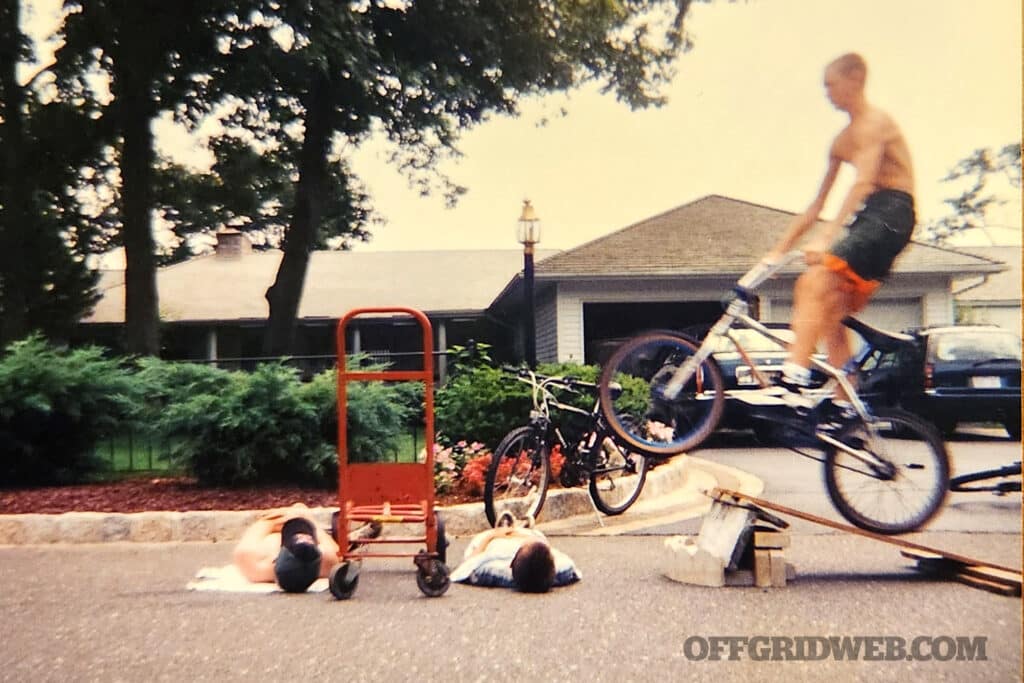
“The start of my street riding, back when we were kids making ramps out of whatever we could find in the garage.”
Around the start of my senior year — this was in 1999 — I had been dating a girl who cheated on me. I didn’t join the military because my girlfriend cheated on me [laughs] but it was a wake-up call. I was like “dude, I almost chose a school that would keep me closer to her and made a five-year university commitment.” Then, when I looked at it even deeper, I was like, “Do I even want to be an architect to begin with?” I was making all these decisions in my life based on what other people were suggesting that I do.
Going into senior year, I realized I really enjoy adventure, I like to fight, I’m passionate about Muay Thai and I train all the time. Being in that straight-edge punk rock hard-core scene, I was anti-drug and alcohol. I had heard rumors of this military group called SEAL Team 4 that was hunting drug lords like Pablo Escobar down in Central and South America. I’m like, “Wait, the military fights drug cartels? How do I do that?” Before that, I don’t even think I knew what a Navy SEAL was. At the time, there might have been one or two movies out there, like the Charlie Sheen Navy SEAL movie. I had never seen that or read a book about it at the time, so it was a big mystery to me.
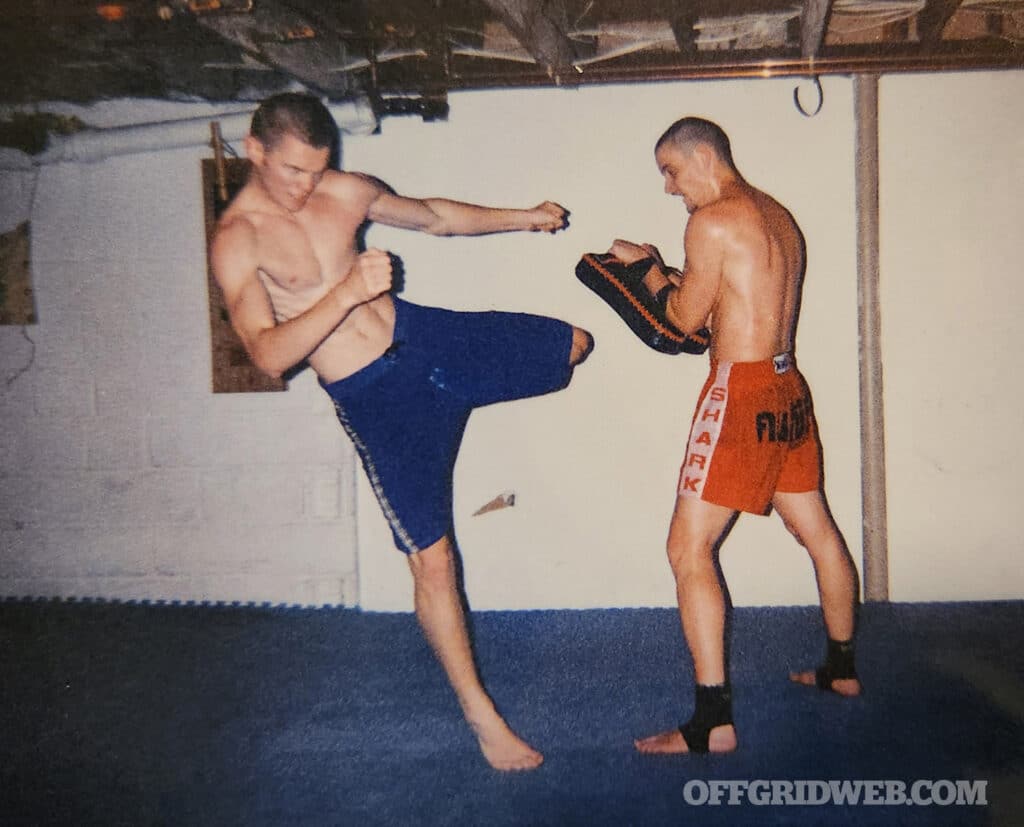
“Thai boxing in my instructors basement in New Jersey, around age 16.”
Then, everyone was like, “Dude, you’re too small, you’re too skinny, you can’t be a SEAL! Do you have any idea how hard that is?!” I like a challenge, so the more people who told me I couldn’t do it, the more I wanted to do it just out of principle. That led me into turning down those scholarships and redirecting toward the Navy Delayed Entry Program. Everyone scared the sh*t out of me of, like, “Dude, you have no idea what you’re getting into,” so I was training non-stop to make sure I was ready. Following my graduation from high school in 2000, I left for bootcamp at the end of that summer.
How long were you active as a SEAL and what roles did you fill during that time?
I was in the Navy for six and a half years, so I was at the SEAL team for probably five years. I went through to boot camp and then went right into the Naval Special Warfare pipeline. So outside of boot camp, the entire time was in Naval Special Warfare. But that got cut short — I say cut short because I didn’t get out at the six-and-a-half-year mark on my terms. It was a medical condition I developed while I was on deployment that basically made me ineligible to pass the Navy’s jump and dive physical requirements due to health issues. I basically got pushed out of the Navy. Overall, I did two deployments with SEAL Team 10, finished up at SEAL Delivery Vehicle (SDV) Team 2, that’s mini submarines. I spent a year there with that command.
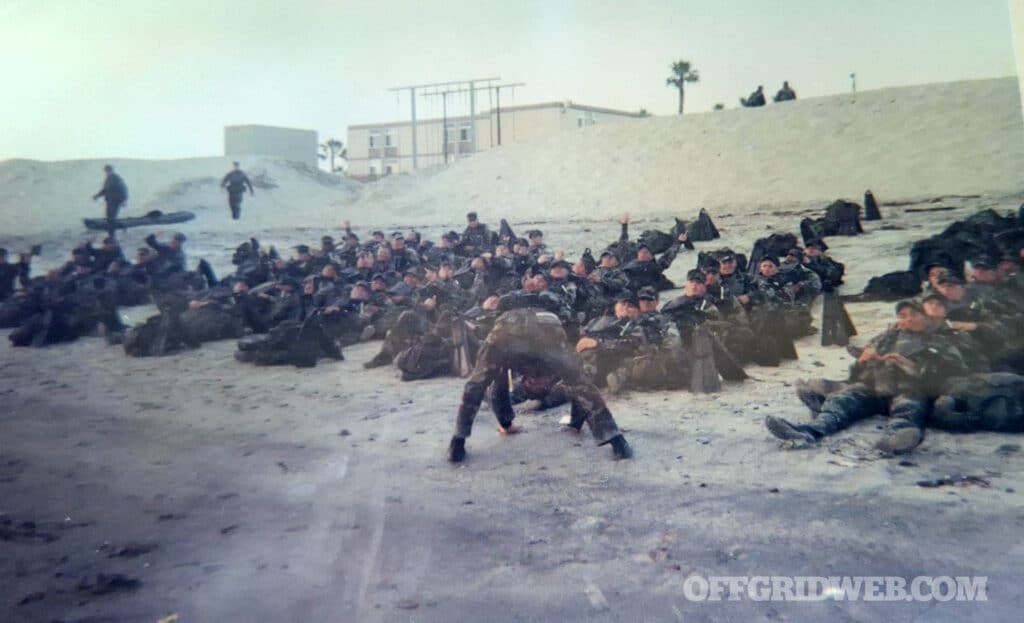
At BUDS Class 236 during Hell Week.
There were so many roles and aspects to the job. My main thing was being a point man and scout reconnaissance sniper. Everyone does multiple jobs, so obviously I knew how to do the assaulter stuff and whatnot. I knew manual breaching. I wasn’t the breacher, but we did a little bit of everything.
What were some memorable lessons you learned during that part of your life?
During the process of getting there, I learned the importance of keeping a positive mental attitude — not necessarily false motivation or trying to pump yourself up, but basically not giving in to fear and doubt and noise. People who have bad attitudes are always looking for an excuse or a reason why something won’t work. If you’re trying to find a reason to quit, you’ll find one. That’s one of those things that you’ve got to be very careful with because people with negative attitudes will draw more people to them. Very rarely do people quit something by themselves. Usually, they try to have other people join them to make them feel like their decision was merited. By just being solutions focused, keeping a positive attitude, being careful of your self-talk or internal dialogue, you can achieve great things.
We heard that you trained and supervised security forces at the Olympic Games. What was that process like?
Yeah, it was interesting. My first deployment cycle was during the 2004 Olympics in Greece. We went over and trained the counterterrorism tactics for the Navy and the police and the Air Force. My shooting partner and I took the Greek Air Force and Coast Guard guys up in a helicopter and coached them through their very first sniper shoot from a helicopter. Eventually, we pulled out and handed things off to the next group that was actually going to be there for the event.
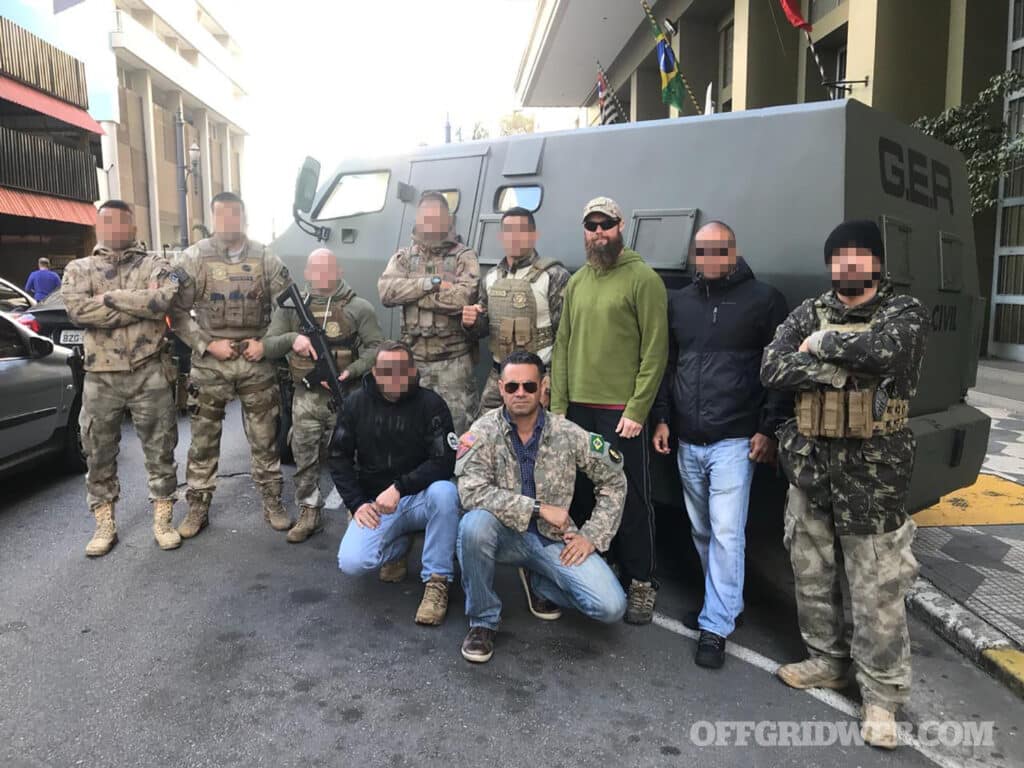
Rio de Janeiro, Brazil, with BOPE and other special tactics teams.
I’ve also been working down in Brazil for probably 12 years now, helping police with fundamental skills and team tactics for taking on organized crime syndicates. I’ve developed a lot of contacts there over the years. At one point we had American Olympic athletes coming down with their families, and Rio de Janeiro is a very dangerous city, especially if you don’t know the flow of everything. We organized a security team of off-duty police officers to come in and provide security escorts and drivers for the athletes and their families as they were attending the Olympic Games down there.
How did the concept for Full Spectrum Warrior begin?
It started with being a fighter. The amount of training that goes into fighting is so much more than just simple technique. Most people who are in the martial arts or MMA world understand that. A professional fighter might be doing stand-up strike training and Brazilian jiujitsu training, but in conjunction with that, they need to be running and doing cardio, doing strength training, doing flexibility and range of motion training, and sticking to a diet. A lot of these guys have faced loss and are trying to come back, so they need to have a coach for their mindset. They’re also managing their own money because unless you’re making huge money as a fighter, you’re coming out of your own pocket for training. You have to have a budget.
In the military, you see guys at the highest level and think, “Man, these dudes have got all their sh*t together.” On the job they might, but then you realize they have the same problems that everyone else has. Their lives are still complicated. There’s an 85-percent divorce rate within the community. Guys have financial problems just like everyone else. Guys have bad vices with alcohol or gambling or whatever.
So, how do you maintain a winning edge without letting the little things metastasize into something that actually takes you out? We see that with someone — not to throw him under the bus — like Tiger Woods. Tiger Woods didn’t lose his spot on top because he got bad at playing golf. He was committing adultery everywhere he went and that’s what lost sponsorships. That’s what took him out of the game, messed with his family life, and ruined his finances.
When we start looking at the bigger picture, there are a lot of attributes that we have to develop as an individual that are above and beyond the technical skill of whatever it is that our job is calling for. The Full Spectrum Warrior system has 17 pillars. One is strength training or your ability to move. One is your health. Another is your ability to be dangerous and your ability to fight. And then there’s technical skill, like firearms training. But several of the pillars are more on the personal development side, which puts the balance and stability behind those physical and technical attributes. And the cornerstone to it is faith.
Where are you pulling your guiding principles from without a foundation in faith?
You’ve trained in a variety of combatives disciplines. What’s your approach to combining all these systems into a versatile skill set?
It started with a background of Thai boxing. My fitness level, my ability to move and generate explosive strength for strikes, and so on. Obviously, the bigger, stronger, and more athletic I am, I’m giving myself an edge if there’s nothing in my hands. Anything that I add to that, I would consider it upgrading the strike. So, if I have an edged weapon, brass knuckles, or if I picked up an object, now I’ve upgraded my strikes. The next layer out from that would be the ability to make strikes at a distance, and that’s where we get into projectiles.
If you look at old-school battlefield fighting, it goes hands, to dagger or hatchet, to swords, to bow and arrow. Once an opponent closes the distance, you’re not shooting the arrow anymore, you’re back to the swords. So, there’s this ebb and flow of what’s the right weapon for the right time. Let’s say I forced you to fight someone in a phone booth and you could have a shotgun or a knife. Which one would you take? In that space, the advantage is with the edged weapon.
When you don’t train your ability to fight with your hands, or with handheld weapons, you’re setting yourself up for failure. You’re going to have a false expectation that your gun will always be able to handle the situation for you. Now, if you’re older, or disabled, or small, or something like that, maybe the firearm is the equalizer, and you train with it to level the playing field. But if you don’t have a handicap that’s limiting your ability to generate force, empty-hand skills are a critical part of the overall martial art system.
Another thing that’s especially relevant to law enforcement — if an officer doesn’t have the ability or confidence to work with his hands and he’s dealing with someone who’s being non-compliant, his next step may be to skip all the in-between levels of force. If the bad guy is at a level three, but the officer’s empty-hand capability is only a level two, now he may jump to excessive force using an eight, nine, or 10 with a gun because he’s afraid to work in the middle ground. Empty-hand combatives ensures we don’t get backed into a corner and have to go excessive because we have no middle ground.
How has getting married and becoming a father influenced your preparedness mindset?
It’s a lot of responsibility. I’m probably going off on a tangent for your article, but there’s that movie No Escape with Owen Wilson. He’s over in Southeast Asia as a contractor for some energy company or something, and while he’s there, a civil war breaks out. He’s with his wife and two little girls, and he’s trying to get his family out of the city without getting killed. Dude, it’s absolutely horrifying. To me, this is scarier than any horror movie with Jason.
Being a father makes you ask, “How do I budget things correctly? How do I make sure that the finances are in check? If there’s an emergency, do I have the food and medical supplies and water purification, the ability to be mobile, and all that stuff, not just for one person, but for two people and a little child?” It’s been a great experience so far, but it’s definitely made the responsibility side of the house way more serious. As a dude, you might be able to just suck it up and rough it out, but when you’re caring for an infant, your decision-making process needs more scrutiny.
When did you begin building the Deep Woods Ranch training facility? What are some of the current features, and what do you plan to add in the future?
In the past, I spent years traveling all over the country and to other countries. I was on the road probably eight months out of the year, and everywhere I showed up to, I had to work within the constraints of that shooting range’s rules and regulations. But when I went to private properties like farms or hunting lodges, we could do some really unique training because it wasn’t a public range with lots of people walking around. At these private properties, it was just us. After doing that for years and starting to get burnt out on it, I was like, “You know what, I should just find a place, build my own stuff, and have people start coming to me. I can set up really unique training that you can’t get at these other places that I’ve seen.” So that’s what we did.
Nine years ago, I sold my house, sold the gym location I had, bought the ranch, and moved out here. We started slowly putting in everything from the infrastructure to the precision rifle range. Currently, we’re building out a Simunition shoot house. It’s going to have two floors, which will make it more than 5,000 square feet of working training space. It’s going to be modular, so we’ll be able to switch it up. Also, right now our precision rifle range goes out to 850 yards. My brother got the neighboring property, so now we’re going to push it out to probably 1,100 to 1,200 yards. We just keep adding stuff.
Tell us about the Home Front K9 Project and its goals.
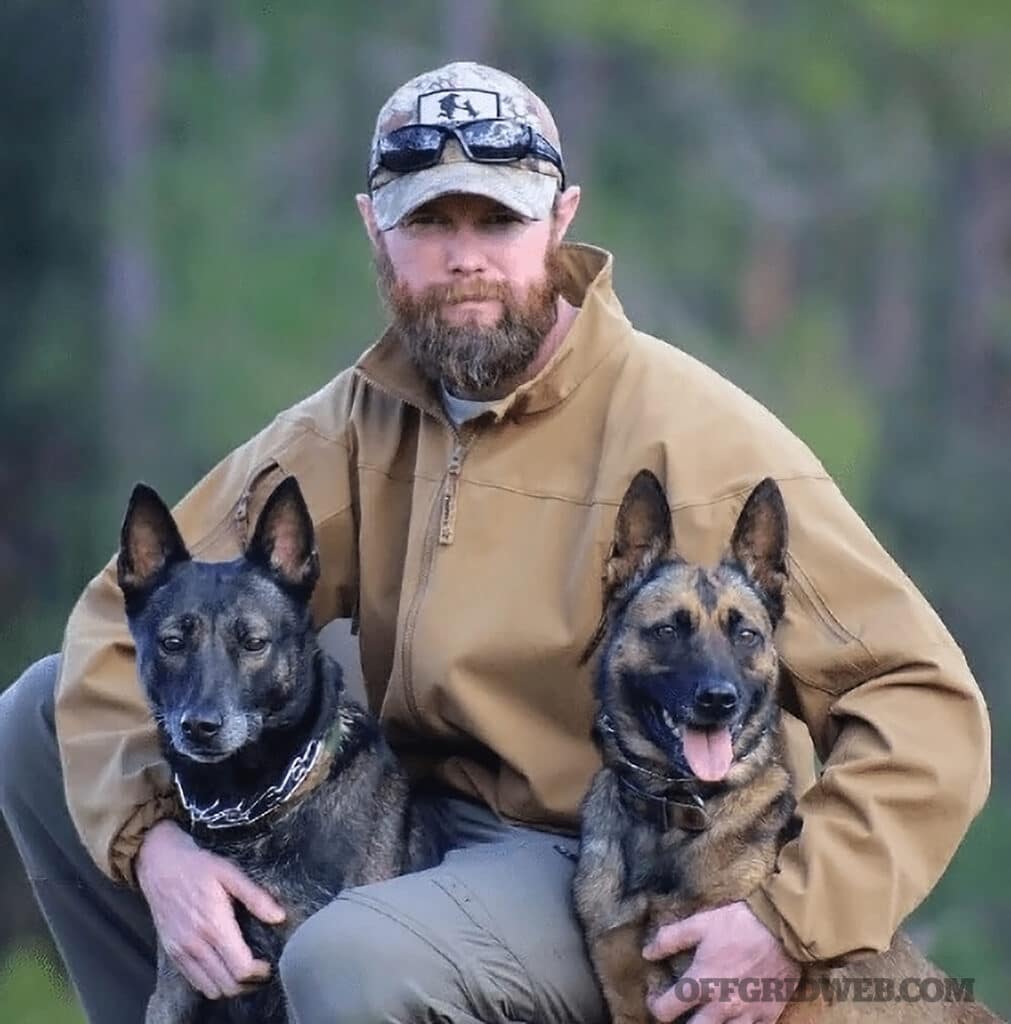
Graham started the Home Front K9 Project, a 501(c)(3) nonprofit organization that donates emotional support dogs, service dogs, and family home protection dogs to active-duty Special Forces families.
Home Front K9 Project is our nonprofit where we train service dogs for Special Forces families. One of the ways we wanted to start serving the community was getting service dogs into the families before guys were veterans, if possible. Again, the divorce rate within the SEAL team is 85 percent, and we wanted to start looking at ways where we can start supporting the families earlier on and have a bridge to bring families back together. It’s been really successful so far. We’re a small nonprofit, so we’re not pumping out like 100 dogs a year — normally we do anywhere from four to eight dogs a year and try to emphasize quality over quantity.
As we speak, only a few weeks have elapsed since the attempted assassination of Donald Trump in Pennsylvania. Given your experience as a SEAL operator/sniper and security consultant, what was your reaction to that incident?
It’s been said a lot now, but my initial assessment — the very first thing that I said when we saw the video of the Secret Service guys on the roof right behind Trump — was, “Why wouldn’t you have a sniper team on the other elevated object?” That’s Tactics 101, crossing sectors of fire. Why wouldn’t you have a secondary team, one which would be able to see across and one that’s looking right down the front? This is day one, week one sh*t. That was the first thing I noticed.
The second one was, if they had known that there was someone of interest on the property, why wouldn’t they simply tell Trump not to go on stage yet? They were looking for this dude, and there were different reports. They could have stalled. They could have played music, or said “Hey, guys, we’re going to take a 10-minute break.” They could have had him come off the stage.
Those are the two main things right off the bat that just did not seem to make sense. They’re easy fixes. The report keeps changing about if the guys were on that roof and then they got pulled off, but that was a total failure as far as baseline security stuff. You can’t do sniper overwatch on a crowd like that from one single position, especially on an event that has that many people.
It’s no secret that there’s an elevated sense of division and discord in America right now, and this is likely to worsen as the presidential election approaches. How should a prepared citizen respond?
Look back to what happened during the George Floyd BLM riots and the Antifa riots of 2020. Understand that we’re probably going to see that, but bigger. So whatever lessons you gathered from 2020, keep those in mind. As silly as it is, that might be anything from toilet paper to water supplies, to having more than one route to wherever you need to go, to being prepared to find yourself on a blocked highway or road. How do you navigate that situation? If someone yanks you out of your car at one of these roadblocks, what is your game plan? Start thinking about that now, so that way, come this fall, you’re not surprised. You can see it already happening with the Israel-Palestine protests.
It doesn’t matter which excuse or label is on it. You have people in the country who want to convert our country to socialism, Marxism, communism, one of those forms of government, not free market capitalism. So, whatever label they use, whatever the rationale is, it doesn’t matter. They’re going to push back in a very loud and violent way. Start getting ready.
Earlier this year, a bill was introduced to the U.S. Senate: S.3589, also known as the “Preventing Private Paramilitary Activity Act of 2024.” It aims to make it illegal for groups of three or more citizens to “publicly patrol, drill, or engage in techniques capable of causing bodily injury or death.” What are your thoughts on this?
This is an attack on the American people, an attack on the law-abiding citizen. Going back to what we just said, the ame people who allowed the cities to burn in 2020, these are the people who have been putting laws into place that theft is no longer a crime if it’s under $900. And then every store is getting ransacked and they’re trying to gaslight you, telling you that the crime has gone down. No, crime’s gone up. You guys just redefined what crime actually is.
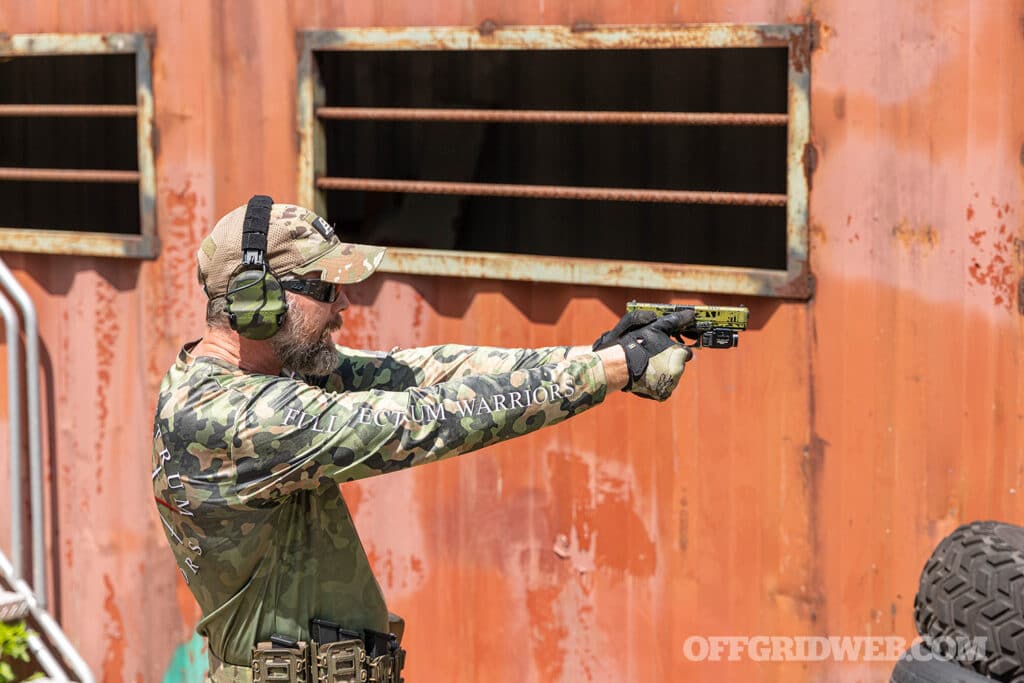
Running pistol drills with his customized Glock 17. It features a slide cut, stippling, and Cerakote by Savage Customs, as well as a Grey Ghost Precision barrel and Streamlight TLR-7.
The same people who are allowing that are the ones who are trying to make it illegal for you to train so that you can protect your home, protect your business, protect your family. That’s really who this is. And they’ll argue that it’s for the right-wing militias or nationalists or this and that. The reality is their goal at the end of the day is to disarm the American people. One of the ways that they’re going to do that is to make all the people who are trying to train to protect themselves out to be the bad guys and not the actual criminals. Criminals will be viewed as the victims of a failed society or system. They’re going to say that you’re some extremist militia, Nazi sympathizer, you name it. Just put the whole list of “isms” behind your name. This is one step closer to how they can demonize people who are practicing and participating in their natural rights.
Like many of us in the firearms and preparedness community, you’ve faced substantial online censorship as a result of the content you share. Do the benefits of engaging in social media outweigh the drawbacks? Where do you draw that line?
Yeah, this has been very frustrating. Part of the attack is demonetization. Part of your income is being taken away for participating in something that is constitutionally legal. And again, at the end of the day, the goal is to disarm the American people. The companies are doing the government’s bidding, just like they’re throttling political stuff. It’s come out before Congress that the Biden administration was directing Facebook and these other organizations to throttle or de-platform certain political people. They’re doing the same thing with the 2A community, and they don’t have the legal authority to do it, so they’re doing it through private companies.
Is it surprising to me? No, it’s not. It’s very frustrating, though, when the companies start messing with your income and suppressing your ability to reach people who follow you, all around a topic that is constitutionally protected. There is no crime being committed — it’s not like we’re talking about child pornography or something, but there’s a lot of that stuff that is allowed to go on, and they turn a blind eye to it.
We’ve got our own thing, the Full Spectrum Warrior University, where we have all our videos on a private server. But as frustrating as Instagram, Facebook, and YouTube are, the 2A community hasn’t really left those social media networks yet. You’ll hear talks about Rumble or some of these other alternative platforms, but what we’ve seen personally is when we try to put our stuff over there, it doesn’t get nearly the reach as it did when we were on the original ones. So, we’re basically just holding on to the network that we had. It’s not growing anymore.
How does your faith impact your outlook on the future?
There is a lot of gloom and doom out there right now, a lot of frustrations, and a lot of worry. I read what it says in Revelation — it says in the end times, good will be bad, and bad will be good, and everything’s inside out. When I read that, it’s like, dude, this has already been said. We know what’s coming. This is part of the process, so get right with God. Stay in God’s favor and keep it in perspective.
As much as I want to get mad at what happened with things like the mockery of the Last Supper at the Olympics, I’ve just got to have faith and trust that people will see what happens when we remove God from the picture. I just hope that more people will be led back to their faith by seeing what a society looks like without God’s influence — how dark it goes, and how corrupt and evil it becomes. I hope through all of this that it just brings more people to walk with the Lord, and that the devil’s schemes fall back and hit him right in the face.
Here’s a way to look at it, too. If I am remotely prepared, then I don’t have to do evil things to take care of my family. There are a lot of people who are like, “Yeah man, when the time comes, I’ll just shoot my neighbor and take his sh*t were prepared, then you’re not put with your back against a wall to take care of your family. You’re being responsible. It’s easier said than done, but it’s something that you should start taking into consideration now.
If our readers want to train with you or follow your latest projects, how can they do that?
I’d love to train with everybody. Check out our website fullspectrumwarriors.com. It has links to our social media including our Instagram page at @fullspectrumwarriorusa, and you can check out our training calendar. We run some public classes, but honestly, the main thing that we do is small group private training events. You can fill out a private training request on our website. It could just be you or just your family, it could be your six best friends, or whatever. We’ll put together a customized training package specifically for you and what you want to learn, and everyone can come stay here on the ranch. We’ve got a guest cabin, a pool, a gym, all that stuff here, so you can just get fully immersed and stay however many days you want to.
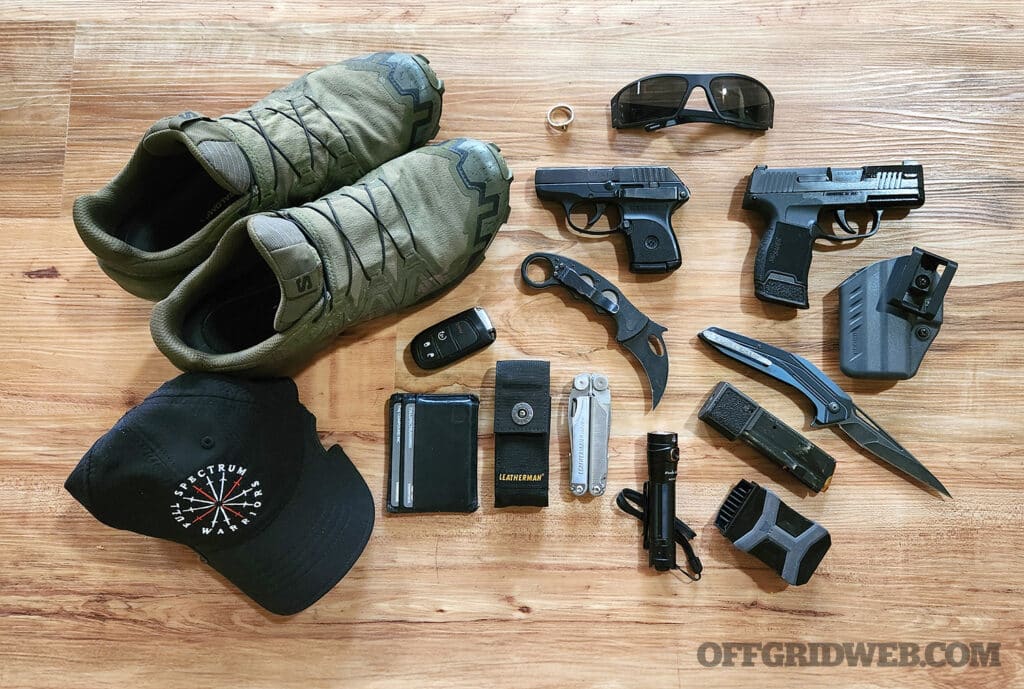
Rich's EDC Gear
“Being that I live in Florida, there is a 50/50 chance I am wearing shorts with a belt or board shorts/silkies, which have no belt system.
For the no-belt setup, I roll out with my pocket rocket, the Ruger LCP .380 Auto with a Kel-Tec carry clip mounted on the side so no holster is required. This is accompanied by my Emerson Karambit folding pocketknife.
If I do have a belt, my preferred carry option is the SIG Sauer P365 with 12-round extended magazine. This gives me a good grip and a decent amount of ammo while maintaining concealability in a Blackhawk holster. That is accompanied by a backup 15-round magazine in a Pitbull Tactical universal magazine carrier. My pocketknife with this setup is a Brous Blades folder.
Additional items I usually have with me are a Leatherman Wave multi-tool, Fenix LD30 flashlight, Silent Pocket RFID blocking card carrier, Gatorz Eyewear Magnum sunglasses, Full Spectrum Warrior Notch Gear hat, Salomon Forces Speedcross 6 sneakers, and my one and only piece of jewelry — my wedding ring.
In most cases, I have a medical kit close by in my vehicle, stroller, backpack, etc., but don’t typically carry it on my first line of clothing in town.”
Rich Graham Vital Stats
- Age: 42
- Hometown: Brielle, New Jersey
- Family: Wife, daughter, Belgian Malinois
- People Who Inspired Me: My father and grandfather
- Favorite Movie: “Mel Gibson and Denzel Washington movies are always a good choice.”
- Favorite Food: Steak or Panang Curry Chicken
- Favorite Drink: Monster Ultra Zero (white can) or Thai iced tea
- Favorite Quote: “If you’re going to be stupid, you’d better be tough!”
Rich Graham's Recommended Reading List
- The Holy Bible
- 21 Irrefutable Laws of Leadership by John Maxwell
- 360 Degree Leader by John Maxwell
- Wild at Heart by John Eldridge
- Think and Grow Rich by Napoleon Hill
- What to Say When You Talk to Yourself by Shad Helmstetter
- The Tongue: A Creative Force by Charles Capps
- Outwitting the Devil by Napoleon Hill
- How to Win Friends and Influence People by Dale Carnegie
- The Slight Edge by Jeff Olson
Where to Find Rich Graham
Sources
Read More
Don’t miss essential survival insights—sign up for Recoil Offgrid's free newsletter today!
Check out our other publications on the web: Recoil | Gun Digest | Blade | RecoilTV | RECOILtv (YouTube)
Editor's Note: This article has been modified from its original version for the web.
The post The Warrior’s Path: Interview with Rich Graham appeared first on RECOIL OFFGRID.
By: Nick Italiano
Title: The Warrior’s Path: Interview with Rich Graham
Sourced From: www.offgridweb.com/preparation/the-warriors-path-interview-with-rich-graham/
Published Date: Fri, 18 Oct 2024 11:00:37 +0000
------------------------
Did you miss our previous article...
https://bushcrafttips.com/bushcraft-news/the-revival-of-barter
 What is BushcraftSurvival SkillsToolsVideosBushcraft CampsBushcraft KitsBushcraft ProjectsPrivacy PolicyTerms And Conditions
What is BushcraftSurvival SkillsToolsVideosBushcraft CampsBushcraft KitsBushcraft ProjectsPrivacy PolicyTerms And Conditions
